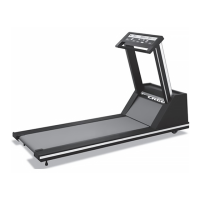What to do if Mortara Quinton CR60 Treadmill shows error E103?
- JJason KelleySep 14, 2025
To resolve error E103 on your Mortara Treadmill, replace the controller.

What to do if Mortara Quinton CR60 Treadmill shows error E103?
To resolve error E103 on your Mortara Treadmill, replace the controller.
| Running Surface | 20 in x 60 in (51 cm x 152 cm) |
|---|---|
| Weight Capacity | 400 lbs (181 kg) |
| Dimensions | 83 in L x 34 in W x 56 in H (211 cm L x 86 cm W x 142 cm H) |
| Display | LCD |
| Motor | 3.0 HP continuous duty |
| Emergency Stop | Yes |
| Programs | Multiple pre-programmed exercise protocols |
Details Mortara's responsibility limitations and conditions for warranty claims.
Provides contact information for technical support, sales, and service across different regions.
Defines conditions under which Mortara is responsible for product safety and performance.
Outlines the user's duty for maintenance and proper operation to prevent failures.
Explains equipment identification and copyright/trademark notices.
Informs about potential document changes, warranty disclaimers, and no commitment to updates.
Details warranty terms, duration, and exclusions for components and products.
Provides essential safety precautions and warnings for operating the treadmill and connected equipment.
Explains the meaning of various symbols and warning labels found on the treadmill for user protection.
Provides instructions for disinfecting the treadmill, emphasizing no liquids on the deck surface.
Daily cleaning instructions for the treadmill exterior and walking belt.
Weekly maintenance: vacuuming under the treadmill after elevating it.
Periodic internal cleaning recommended by an authorized technician for dust/lint accumulation.
General cautions regarding cleaning: unplugging power and avoiding liquid ingress.
Specifies emission tests, compliance levels, and guidance for the electromagnetic environment.
Details immunity tests, compliance levels, and guidance for the electromagnetic environment.
Provides recommended separation distances for RF communications equipment to avoid interference.
Table detailing separation distances based on transmitter power and frequency to prevent interference.
Overview of the CR60 treadmill features: walking surface, speed, grade, and controller.
Illustrates and labels the main components of the treadmill configuration.
Introduces the controller and the power circuit breaker's function for operating the treadmill.
Describes the computerized control panel for operating the treadmill and its displays.
Explains the function of each key on the treadmill controller panel.
Details the different displays and indicator LEDs on the controller and their functions.
Procedure to configure the treadmill's speed range when replacing a controller.
Introduces limited access, time limit, and speed limit controls for restricted or controlled treadmill use.
Lists available accessories and their part numbers, such as handrail kits.
Provides essential safety instructions for patients and staff when using the treadmill.
Explains how to use the controller keys for operating the treadmill, with safety warnings.
Describes the auto-reset function if the treadmill is inactive for five minutes.
Details how to activate and use the limited-access control with a magnetic key for security.
Instructions for setting and deactivating the time limit for treadmill use.
Procedure to set and deactivate the speed limit for treadmill operation.
Steps to change the default unit of measurement (English/metric) for displays and calculations.
Step-by-step instructions for safely mounting and dismounting the treadmill belt.
Detailed steps for powering on, setting parameters, and running the treadmill.
Daily checks for wear on the power cord and walking belt, and belt centering.
Instructions for cleaning the exterior and interior of the treadmill, with safety precautions.
Procedures for disinfecting the treadmill, advising against liquids on the deck.
Lists tools required for adjustments and warns about clothing hazards.
Procedure for adjusting belt tension when the belt slips or moves unsteadily.
Instructions for adjusting the belt tracking when it moves to one side.
How to determine total distance and time usage for service scheduling.
Requirement for periodic electrical testing, including leakage current checks.
Safety warnings and steps for moving and storing the treadmill, requiring two people.
Checks required before reusing the treadmill after moving or storage.
Initial troubleshooting steps for common issues and contact information for support.
Lists and explains system error codes (E101-E105, E201-EPLO) displayed by the controller.
A guide matching treadmill problems with their possible causes and remedies.
Detailed specifications for performance, physical dimensions, environmental, and power requirements.
Specifies controller display types, units, range, increment, and accuracy for speed and grade.
Details the multifunction display, including parameters like calories, caloric rate, METS, and scan.
Graph illustrating the relationship between treadmill speed and user weight.
Table and formula showing the relationship between treadmill grade percentage and angle in degrees.
Instructions for verifying received items, inspecting for damage, and handling shipping claims.
Recommends professional installation and verifies equipment condition and connectivity.
Specifies requirements for the power line and operating environment, including clearance and surface.
Step-by-step guide for installing the treadmill, including tools and procedures.
Continues installation steps for attaching the hood and grounding brackets.
Final installation steps: hood cover, front-end caps, power verification, and speed range configuration.
Procedure for testing all treadmill functions, including speed, grade, and belt operation.
Describes the function of each control key on the treadmill controller, including Power and Units.
Explains the Clear key's function for erasing readings and resetting the timer.
Details the Select key's dual function for entering user data and choosing display parameters.
Describes the Cool Down key's function to slow the treadmill for a cool-down period.
Explains the function of the Stop Belt keys for gradually stopping the walking belt.
Explains how to activate and deactivate the limited access control using a magnetic key.
Instructions for setting and deactivating the time limit for treadmill use.
Procedure to set and deactivate the speed limit for treadmill operation.
Describes the three controller displays: grade, speed, and multifunction.
Explains the function of indicator LEDs like Enter Weight and Enter Time.
Explains the LEDs adjacent to the multifunction display indicating selected parameters.
Explains the LEDs for MPH/KM/H indicating the selected unit of measurement.